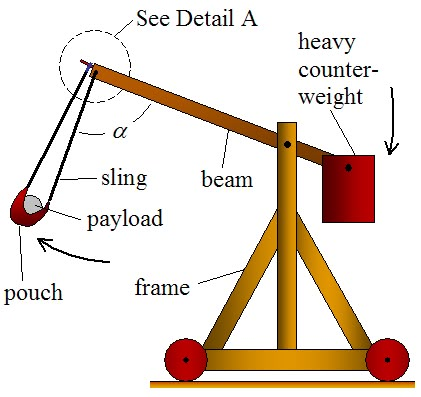Trebuchet Vs Catapult

Trebuchet vs catapult
Roughly speaking, a trebuchet has a few advantages over a catapult. First, it can handle heavier projectiles. A catapult's maximum weight tops out at about 180 pounds; trebuchets top out at about 350. Second, compared with a torsion engine, it's a fairly robust machine.
Can a trebuchet throw farther than a catapult?
A trebuchet (French: trébuchet) is a type of catapult that uses a long arm to throw a projectile. It was a common powerful siege engine until the advent of gunpowder. The design of a trebuchet allows it to launch projectiles of greater weights further distances than that of a traditional catapult.
What are the 3 types of trebuchets?
Three Types of Trebuchet and Their Motive Force. There are three historical types of trebuchets: the traction trebuchet, the fixed counterweight trebuchet, and the swinging, or hinged, counterweight trebuchet, using two types of motive force: man power and gravity.
What advantages does a catapult have over a trebuchet?
While catapults could be reloaded more quickly, their range was less and their payload lighter. Trebuchets were very heavy and often built on-site, and were not designed to be mobile, but to lay siege to a castle or city and destroy its protective walls.
What are the disadvantages of a trebuchet?
Disadvantages. Although trebuchets have greater power and range than catapults, they also have drawbacks. Trebuchets are more complicated than torsion catapults and therefore are plagued by mechanical breakdowns, require more maintenance, more skill to operate and a larger crew.
Which came first trebuchet or catapult?
Use of catapults is first recorded around 400 BCE in both China and Greece. Many threw stones, but some were designed to fling darts or spears. The version known as the trebuchet came later and was used until the advent of gunpowder weaponry like the cannon.
What are the 4 types of catapult?
The main types of catapults used were the trebuchet, mangonel, onager, and ballista.
How fast could a trebuchet fire?
“The traction trebuchet offered an impressive rate of fire: A 1991 experiment conducted on a model made to ancient standards at the University of Toronto showed that a well-coordinated trebuchet crew could fire four rounds per minute.
What was the largest trebuchet in the world?
The Warwolf, or War Wolf or Ludgar (French: Loup de Guerre), is believed to be the largest trebuchet ever made. It was created in Scotland by order of King Edward I of England, during the siege of Stirling Castle, as part of the Scottish Wars of Independence.
How far could a trebuchet throw?
The farthest distance thrown by a trebuchet (with projectile weight of 20kg and over) is 133.75 m (438.81 ft), and was achieved by Sierra Nevada Brewing Company (USA) in Chico, California, USA, on 2 March 2021. The projectile was in the air for approximately 5.53 seconds.
Did Vikings have trebuchets?
No, they did not.
Did Romans use trebuchets?
The trebuchet is a catapult device used to throw an object. The classic trebuchet was not perfected in Western civilization until the Middle Ages. That would mean that it was not available for the Roman legions to use. However, the Romans did develop the Onager catapult which was a predecessor to the trebuchet.
What are the disadvantages of a catapult?
Disadvantages. Their flat firing trajectory and limited range, along with the impossibility of aiming the machine effectively, made onagers and mangonels unsuitable for bombardment of fortified positions, as the projectile did in the best of circumstances only hit the wall, not the area behind.
What are 5 types of catapults?
There are five historical types of catapults: the mangonel, onager, ballista and trebuchet, using three types of motive force: tension, torsion and gravity. Side view of a torsion powered mangonel catapult in the cocked position.
What are the pros and cons of a trebuchet?
Pros: Able to throw much heavier stones than the Mangonel. It had so much power to it, that it could bring down sections of castle walls. Cons: It had a large amount of supplies that it wasn't really easy to move around. Its slow to operate because of how big it was.
Why do trebuchets need wheels?
Rolling wheels prevent the crushing lurch. Instead, energy is more smoothly channeled into the trebuchet's arm and missile. Wheels add power as the trebuchet rolls forward. Like a pitcher who leans toward home plate as he hurls, the forward motion adds velocity to the pitched weight.
Who invented trebuchet?
The Trebuchet was invented by Mariano Taccola, "the Sienese Archimedes." This war machine was invented during the Middle Ages (around 1400 AD) in order to destroy the great walls of the enemy palaces. The trebuchet was designed to throw heavy stones against the walls and simultaneously kill the enemies.
How far can catapults throw?
Catapults can launch things a fair distance -- 500 to 1,000 feet (150 to 300 meters) is common.
When did catapults stop being used?
Catapults were used extensively throughout Europe (predominantly by the French) until 885-886 AD when new defense systems rendered catapults ineffective.
Do we still use catapults today?
Today, catapults can be used to launch airplanes from aircraft carriers, or to demonstrate physics and mathematics to students.












Post a Comment for "Trebuchet Vs Catapult"